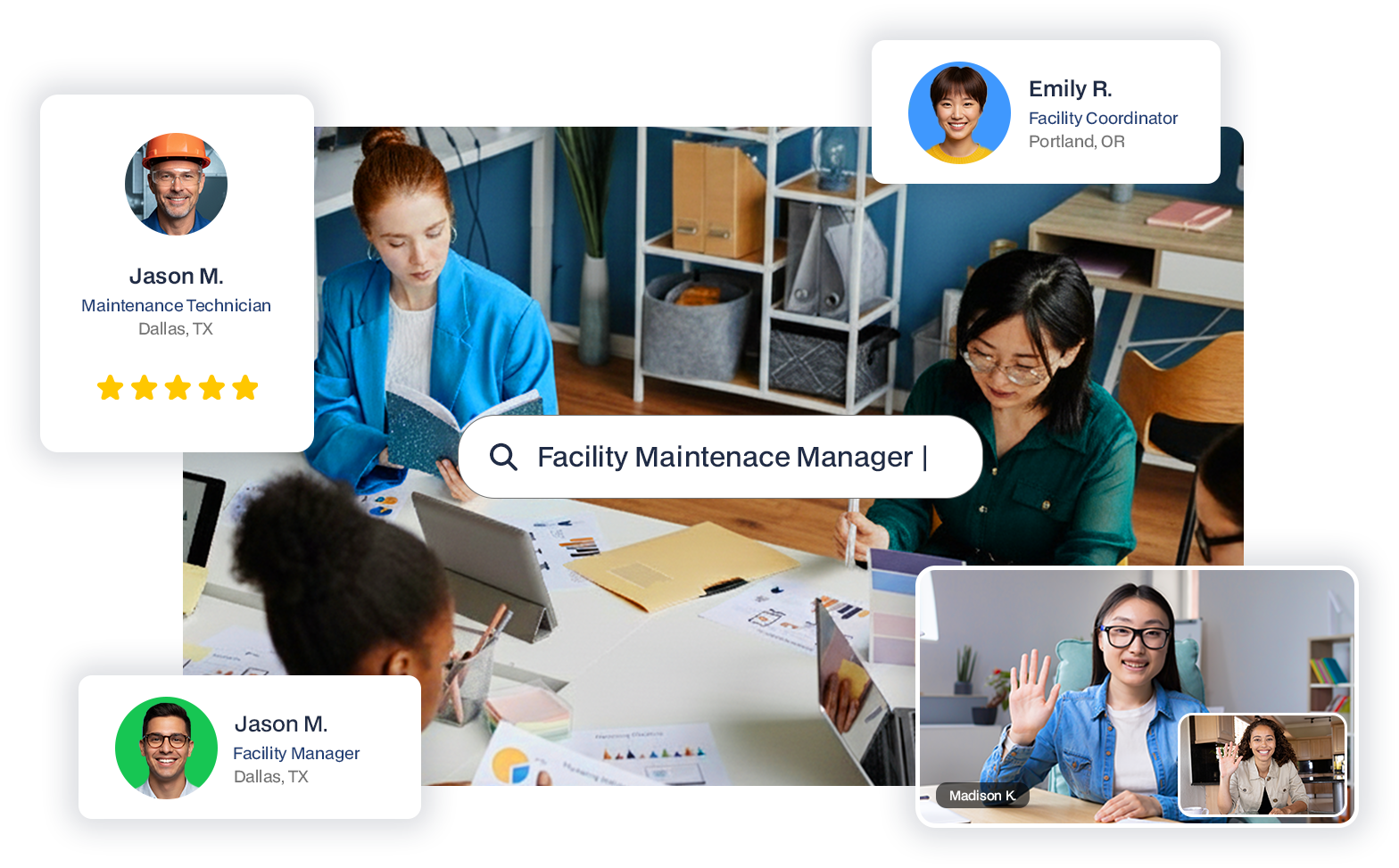HIRING PROCESS GUIDE
The Ultimate Guide to Hiring a Top-Tier Facilities Maintenance Professional.
Let's face it: hiring the right person for a facilities maintenance role isn't a guessing game—it’s a high-stakes financial decision.
“A generic hire doesn't just result in an "okay" team. It creates an operational bottleneck that costs you money. We're talking delayed repairs, unchecked contractor costs, frustrated stakeholders, and a verifiable six-figure hit to your annual budget.”
The industry standard approach is broken: post a generic job description, wade through hundreds of unqualified resumes, and hope for a unicorn. It’s draining, inefficient, and the best-case scenario is settling for mediocrity.
But what if you could change that today?
This guide hands you the key. It's not a collection of tips and tricks. It is our battle-tested, proprietary framework—a predictable, repeatable system designed to help you out-hire your competition, identify true A-players, and build a facilities maintenance team so effective it runs itself.
The 7-Step A-Player Hiring Framework.

Step 1: Document Your Maintenance Management Workflow
Before you can hire the right person, you need to know exactly what they will be doing. You can't just post a generic job description and hope to find a unicorn. You need to understand the role's day-to-day reality, from the biggest projects to the smallest tasks.
A lack of clear job descriptions and Standard Operating Procedures (SOPs) leads to significant productivity losses. A Wrike study found that broken processes hinder employee potential, resulting in an average waste of $15,138 per employee annually on unnecessary work. Wrike: 2024 Impactful Work Report.
If you are going to create an SOP for an individual, you should create your entire work order process document. This detailed document outlines the lifecycle of a work order from beginning to end, defining:
-
What happens under what conditions?
-
Who is responsible for what?
-
Which roles execute which tasks?
-
What a "great job" looks like.
The best way to document this is through a structured conversation with your team, digging into the details of how you run your department:
-
How does a work order originate?
-
Who reports it?
-
What are the routine maintenance tasks?
-
How do they handle emergency repairs?
-
What software or tools do you use?
-
What is the communication process with other departments?
To make this easier for you, we've compiled the exact list of questions we use for new clients. This 50-Point Discovery Checklist is what we use to map every work order process from start to finish.
MAP YOUR WORKFLOWS
Download Our 50-Point Discovery Checklist.
The Exact Questions We Use to Map Maintenance Workflows (Free Download).
This checklist is your key to a comprehensive, 360-degree view of your facilities. It gives you the questions needed to map your processes, identify opportunities, and build a more streamlined system.
Leveraging Al for Workflow Documentation
We recommend recording the conversation (using a tool like Granola Al or Google Meet with Gemini for transcription) to get a complete and accurate transcript.
The resulting long, unorganized transcript is where Al shines. We use the Workspace edition of Gemini Al (or a similar LLM like Microsoft Copilot) to analyze the transcript and turn your conversation into a detailed workflow document. This is exactly the meticulous, two-step process (Al transcription + Expert review) we perfected while streamlining maintenance operations for clients.

If you want the exact copy of the prompt we use (and others we rely on daily), download our exclusive Al prompts guide.
WORKFLOW TO SOP PROMPT
Get Our "Workflow to SOP" Al Prompt (And 7 Others We Use Daily)
Turn messy transcripts into polished SOPs with ease. This prompt equips you with what you need to turn raw conversations into clear structured and actionable SOP documents. No more guess work, just consistent ready to use processes.
Step 2: Build Your Maintenance Coordinator SOP
Once your workflow document is complete, you can define your new hire's responsibilities. You have all the raw material needed to create your Standard Operating Procedure (SOP)—a detailed, step-by-step playbook for the job.
An effective SOP includes the following critical items:
-
Role Title and Purpose
-
Reporting Structure (Who reports to this role, who this role reports to)
-
Key Areas of Responsibility
-
Guidelines for Daily Operations (Start time, end time, and task order)
-
Communication and Notetaking Expectations
-
Follow-up Expectations and Service Level Agreement (SLA) expectations
-
How to Escalate Issues
-
Key Metrics, Best Practices, and Guidelines
The SOP is your primary means of evaluation and training, ensuring your new hire is always working on the right things in the right order.
Step 3: Create Your Maintenance Coordinator Job Description
Building upon the comprehensive SOP, crafting an effective job description becomes straightforward. Your task is to translate the specific tasks and expectations from the SOP into clear, concise, and professional language that attracts suitable candidates.
Focus on highlighting the impact the new hire will have (e.g., increased efficiency, reduction in downtime) and ensure the description is uniquely tailored to your specific workflows.

A solid job description should include these sections:
-
Job Title
-
Summary/Objective
-
Responsibilities (Core duties and tasks)
-
Qualifications (Required and Preferred Skills)
-
Reporting Structure and Team Overview
-
Company Culture and Benefits
-
Call to Action (How to apply)
Step 4: Conduct Focused Interviews
Your interviews must be hyper-focused on evaluating whether candidates can execute your SOP.
PRO-TIP: Send them the Standard Operating Procedure ahead of the interview. Their preparation level will give you immediate insight into their potential punctuality and dedication.
You need to design questions that evaluate candidates in these critical areas:
-
Customer service and problem-solving
-
Facility maintenance knowledge
-
Remote work readiness and communication
-
Learning ability
-
Punctuality and reliability
If you need a running start, download our proven question sets designed specifically for facilities maintenance roles.
INTERVIEW QUESTION SETS
Download Our Proven Interview Question Sets: Target Customer Service, Knowledge, and Learning Ability.
Go beyond resumes and uncover real skills. These interview question sets help you assess problem-solving, technical knowledge, adaptability, and reliability—so you can confidently hire candidates who keep operations running smoothly.
Step 5: Evaluate Your Candidates Systematically
Create a grading tool to score candidates during their interviews on a scale of 1 to 5 for each question area. Your criteria for success may differs from ours.
Here is our Threshold for Success:
-
Take an average of all categories and eliminate anyone who is under a 3.7.
-
Most of our better candidates typically score over 4.2.
-
Anyone scoring 4.7 or higher is an A-player and we immediately try to hire them.
This tool can be easily created in a spreadsheet, but if you'd like to remove all the setup guesswork, get a copy of the exact matrix we use.
INTERVIEW GRADING MATRIX
Get Our Interview Grading Matrix (Scale & Weighting Included)
Bring structure and fairness to your hiring process. This grading matrix helps you evaluate candidates consistently with clear scales and weightings—so you can compare apples to apples and hire with confidence.
Step 6: Make the Right Decision
Our Core Philosophy: Hire for Care, Train for Competence.
Ultimately, you want somebody who is incredibly well qualified and a genuine fit for your team. We prioritize candidates with a high capacity to learn and who excel at teamwork. While a strong baseline of facilities maintenance knowledge is required, we prioritize something deeper when it comes to culture fit:
-
Customer service and problem-solving
-
Facility maintenance knowledge
-
Remote work readiness and communication
-
Learning ability
-
Punctuality and reliability
The worst hire you can make is someone who has the propensity to complain or has a personality of being chronically unique. Optimize for the A-player traits, and the technical competence will follow.
Step 7: Manage Performance with a KRA and Reporting
This step is key to retention and excellence—not just hiring. You need to meet with people regularly to give honest feedback against the SOPS, and you need data to back up your evaluation.
Set up reports that provide concrete evidence, not just anecdotes or "feel." Your industry has clear performance metrics. Some examples are:
-
Follow-Up Efficiency: If their job is to close out work orders, you should see the overall life cycle of work orders decrease.
-
Vendor Compliance: If their job is to drive improvements in vendor compliance, you should see vendors using your system increase over time.
You must set up reports that show both the activity of your team members and the effectiveness of that activity. Without this data, true performance evaluation is impossible and unfair.
Why a Proactive Approach Is Your Best Strategy
This intentional, step-by-step process is the key to building a top-tier facilities maintenance team. It takes the guesswork out of hiring and replaces it with a predictable, repeatable system that delivers results.
Of course, this entire process is a significant, 80-hour commitment—it's weeks of process mapping, documentation, and tool creation. For most businesses, building this infrastructure from scratch is a massive undertaking.
The Easy Button: Let Our Experts Build the System For You.
We specialize in Facilities Maintenance Process Engineering. We don't just help you hire. With our Virtual Maintenance Coordinator (VMC) program, we build the entire system for you, including:
-
The Workflow Document
-
Custom SOPs (Standard Operating Procedures)
-
Our Proven Interview Matrix
-
Performance Reporting Frameworks
We will find you top-quality talent, help you embed them seamlessly into your team, and then micromanage them so that you don't have to.
Recently a customer had this to say about the two VMCs they have working on their team:
"You guys have been able to hold [contractors] accountable in a way that we haven't before. Making sure that stuff gets done — that's really great."
Ready to stop settling for 'good enough' without spending weeks on internal documentation?
STRATEGY CALL
Schedule a 15-Minute Strategy Call!
See our system in action and find your A-player faster.
